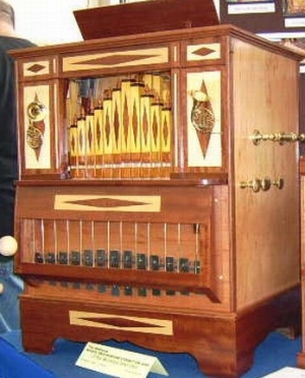The Universal is quite a lot larger than the Busker or the Senior 20, weighing in at around 65 lbs. It can be made with 20 or 26 notes, but uses a windchest into which four rows of 20/26 pipes are plugged. The extra air flow needed for four pipes - possibly all sounding together - instead of just one means that pneumatic valves have to be used. The small air flow passing through a hole in the paper roll 'triggers' a valve, which opens a much larger airway to the set of four pipes. Again, the extra air flow requires larger bellows - three sections being used in place of the pairs of bellows used in the smaller organs.
The four rows - or ranks - of pipes can be turned 'on' and 'off', just like in a church organ, by the use of 'stops'. These stops are actually sliders that have holes to allow - or inhibit - airflow to each rank of pipes. As each row of pipes is constructed to produce a different 'sound', operating the stops during the playing of a tune to switch the individual ranks 'in' or 'out', can change the overall presentation of the music. The instructions and drawings include the designs of several different type of pipes, each with its own characteristic 'sound', from which the constructor can choose the combination he prefers.
A fast rewind system is included for the paper rolls, and a multifunction 'conductor' can be positioned in front of the pipes. The plans and instructions also include details for the construction of a 'glockenspiel' (mechanical metal-bar xylophone), which is fitted to the front of the organ during performances, but which can easily be removed for transportation or storage. This organ is definitely intended to be used on a cart, or on a table top.
